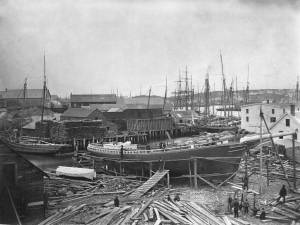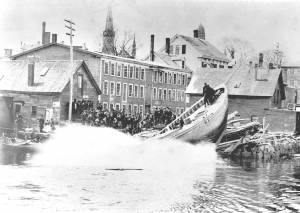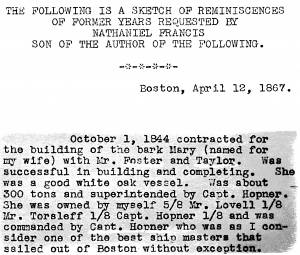An online project under the direction of the CAPE ANN MUSEUM
Historical Materials: Maritime & Other Industries & Facilities
Historical Materials » Maritime & Other Industries & Facilities » Shipbuilding / Repair
You have navigated to this pages from catalog entry: Gloucester Harbor, 1847 (inv. 23)
Shipbuilding / Repair
View related Fitz Henry Lane catalog entries (6) »
To judge from Lane's depictions of Gloucester Harbor, It would seem that the harbor was devoid of shipbuilding activity, with only one painting The Fort and Ten Pound Island, Gloucester (Harbor Scene), 1848 (inv. 58) showing a vessel under construction. While the historical record shows far more shipbuilding activity in nearby Essex, Gloucester did have significant shipbuilding in the years 1800 to 1865, amounting to 93 registered vessels and an unknown number of enrolled vessels. The registered vessels included 82 schooners, four (full-rigged) ships, one bark, four brigs, and two sloops. The numbers of enrolled vessels is unknown, but they were likely to be smaller craft with sloop and schooner rigs, and built in significant numbers. (1)
Official records were compiled by the U.S. Customs Service for all merchant and fishing vessels, registry being applied to vessels trading or fishing in foreign waters and ports. "Enrolment" (as spelled on customs documents) was applied to vessels fishing or trading only in U.S. territorial waters. Registry documents were filed with the Register of the Treasury in Washington, DC, as well as with the local customs offices. Enrollment documents were filed only with local customs offices and were subject to loss due to fires or careless storage, leaving many voids in the record of American coastal fishing and shipping. (2)
Shipbuilding was a time-consuming process, needing a sizeable space for lofting, millwork, storage of shipbuiding timbers and lumber, not to mention the building- and launching ways. Prime waterfront space was not a necessity. As long as the launching incline is straight, and the water is deep enough to float the vessel at high tide, the building site can utilize unwanted shoreline, as it did in Gloucester's Vincent Cove for many years. The likelihood that Gloucester shipyards were in out-of-the-way places around the Inner Harbor is probably why Lane (and his clientele) paid so little attention to them.
The vessel in Lane's painting is probably a very small schooner—more likely to be enrolled than registered. Building vessels on a wharf was common in Gloucester, even into the twentieth century, but launching was difficult for larger vessels. The example in Lane's painting will probably measure (not weigh) about twenty tons - a small vessel which should be easy to launch this way. Needless to say, the launching would take place at high tide, when the drop from wharf to water was minimal.
– Erik Ronnberg
References:
1. Ship Registers of the District of Gloucester, Massachusetts, 1789-1875 (Salem, MA: The Essex Institute, 1944)
2. Forrest R. Holdcamper, "Registers, Enrollments and Licenses in the National Archives", The American Neptune 1, no. 3, 275–83.
Related tables: Graving Beach » // Waterfront, Gloucester »
Print from bound volume of Gloucester scenes sent to the Philadelphia Centennial Exhibition.
11 x 14 in.
Cape Ann Museum Library & Archives
Schooner "Grace L. Fears" at David A. Story Yard in Vincent's Cove.
Also filed under: Historic Photographs » // Schooner (Fishing) » // Vincent's Cove »
Details about Maine's shipbuilding industry, see pp. 252–57.
Also filed under: Castine »
The Practical Ship-Builder: Containing the Best Mechanical and Philosophical Principles for the Construction Different Classes of Vessels, and the Practical Adaption of their Several Parts, with Rules Carefully Detailed. Collins Keese & Co, New York, 1839. Oblong 4to, 17x20 cm, (2), 107, (4) pp, ill., 7 fold. plates.
In Google Books
"October 1, 1844 contracted for the building of the bark Mary (named for my wife) with Mr. Foster and Taylor. Was successful in building and completing. She was a good white oak vessel. Was about 300 tons and superintended by Capt. Hopner. She was owned by myself 5/8 Mr. Lovell 1/8 Mr. Torsleff 1/8 Capt. Hopner 1/8 and was commanded by Capt. Hopner who as as I consider one of the best ship masters that sailed out of Boston without exception. . . .We sailed the bark Mary for three years after making three successful voyages, taking each about one year going from Boston to Norfolk and to Rio and St. Petersburg and Boston and then sold her to Wm. H. Boadman for the sum of $16,500 being about what she cost when new and she had about paid for herself."
Also filed under: "Mary" (Bark) »


